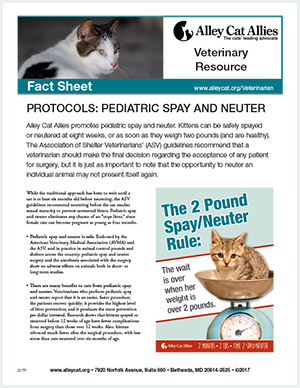Alley Cat Allies promotes pediatric spay and neuter. Kittens can be safely spayed or neutered at 8 weeks, or as soon as they weigh two pounds (and are healthy). The Association of Shelter Veterinarians’ (ASV) guidelines recommend that a veterinarian should make the final decision regarding the acceptance of any patient for surgery, but it is just as important to note that the opportunity to neuter an individual animal may not present itself again.

For anyone who needs help determining a kittens’ age, we have a guide at alleycat.org/KittenProgression.
While the traditional approach has been to wait until a cat is at least six months old before neutering, the ASV guidelines recommend neutering before the cat reaches sexual maturity to prevent unwanted litters. Pediatric spay and neuter eliminates any chance of an “oops litter,” since female cats can become pregnant as young as four months.
- Pediatric spay and neuter is safe. Endorsed by the American Veterinary Medical Association (AVMA), the ASV, the National Animal Care and Control Association (NACA) and in practice in animal control pounds and shelters across the country, pediatric spay and neuter surgery and the anesthesia associated with the surgery show no adverse effects on animals both in short- or long-term studies.
- There are many benefits to cats from pediatric spay and neuter. Veterinarians who perform pediatric spay and neuter report that it is an easier, faster procedure; the patients recover quickly; it provides the highest level of litter prevention; and it produces the most prevention per dollar invested. Research shows that kittens spayed or neutered before 12 weeks of age have fewer complications from surgery than those over 12 weeks. Also, kittens rebound much faster after the surgical procedure, with less stress than cats neutered over six months of age.
- Spaying and neutering outdoor cats improves their lives. Spayed and neutered cats lead healthier and longer lives. Spayed outdoor females are able to enjoy a happier and longer life without the constant stress of endless pregnancies and nursing kittens, and neutered males are calmer and no longer suffer injuries in fights over females and territory. Additionally, spaying and neutering virtually eliminates the chances for mammary and testicular tumors. Even young cats who have been in heat only once have a significantly higher risk of developing mammary cancer.
- Spaying and neutering cats before adoption significantly reduces the number of animals entering animal control pounds and shelters. Pediatric spay and neuter means that animal control pounds and shelters can ensure that 100% of animals leaving their facilities are sterilized. Since compliance rates are traditionally low with spay and neuter voucher programs (where adopters are required to bring the animal back to the agency for surgery), neutering kittens before they are adopted ensures that there is no opportunity to reproduce. Veterinarians who perform pediatric surgeries are helping to stop the birth of kittens who are likely to end up in shelterswhere more than 70% of cats are killed.
- Research and techniques. Research supporting pediatric spay and neuter can be tracked through the Journal of the American Veterinary Medical Association (JAVMA), including the JAVMA 2000 article, “Long-term outcome of gonadectomy performed at an early age or traditional age in cats” by L.M. Howe at al. An earlier article in 1987 by L.L. Lieberman, “A case for neutering pups and kittens at two months of age” is often referenced. Veterinarians agree that the procedure does require some adjustment in technique; these techniques are covered in most veterinary literature and in the JAVMA 1993 article “Surgical techniques for neutering 6- to 14-week-old kittens” by M.G. Aronsohn and A.M. Faggella. Contact JAVMA for copies of these articles. For more hands-on information, visit the Feral Cat Project and Humane Alliance to see videos and descriptions of surgical techniques.
RECOMMENDED RESOURCE:
Pediatric Neutering: A Practical Guide for Veterinarians
In a joint effort, the Association of Veterinarians for Animal Rights (AVAR) and the University of California-Davis, School of Veterinary Medicine have produced an instructional videotape which encourages veterinarians to perform sterilization surgeries on animals as young as six to 16 weeks of age, thus helping to curb unwanted births. The video provides an opportunity for veterinarians who haven’t performed surgery on younger animals to learn about surgical technique, anesthesia, and the benefits of pre-pubertal surgery. Videos still available on a limited basis through UC-Davis for $15, plus shipping and handling. To order, watch the directions here and download here.

